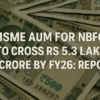Leveraging technology to enhance trust, speed, flexibility, efficiency, and innovation for supply chain financing:

Chandramouli Pandya spent a significant portion of the initial effort on designing and developing a modular micro services-based platform as the first step and later on added more innovative features to the platform
During the earlier days, the banking industry was a laggard in terms of technology adoption. The financial services sector has been plagued with a number of manual intensive processes, a lot of forms to be filled, physical verification by making site visits, among others.
But over the last 5 years, the sector has been undergoing significant technological innovation. Given the extensive amount of data available online, it has become easier to obtain KYC and other supporting details online. Online data sources such as GST filings and E-Way bill details have helped build confidence on the authenticity of transactions. Every day, more data sources are becoming available. This large pool of data and improved data processing technologies have enabled faster processing of applications and also helped the lender make better-informed decisions.
Chandramouli Pandya, CTO, Finovate Capital said: “Financial industry is seeing a lot of innovation in India. Finovate brings innovation and ease of use to Supply Chain Financing. We leverage edge technology to enable unique, innovative, non-traditional Supply Chain Financing programs. Supply Chain Financing has been in existence for a while. However, there is a lot of scope for innovation and improving efficiency using technology. Our mandate is to build a platform that can cater to all types of supply chain products and programs that could exist.”
SOLVING THE CONUNDRUM
Supply Chain Financing has different segments like dealer financing, vendor invoice discounting, early payments and sub-categories within each segment. Most existing solutions primarily focus on a specific segment. The segment has space for products that can offer scalability and could cater to both the existing structures work, and also accommodate newer structures that can take off.
Chandramouli gives the Finovate picture: “So the whole idea of Finovate was to build a platform that would allow us to not only offer all the traditional financing models but also introduce innovative structures. After careful evaluation, we decided to go with a complete custom-built solution. The platform which we have created is flexible and comprehensive, supporting loan origination, management and collection in a single solution. We have been able to work with our lender partners to create structures through the platform that didn’t exist around the supply chain market before. We were amongst the first few solutions to include Blockchain imprinting of invoices in additional to offering extensive data collation and analytics.”
The solution offered by Finovate is modular with various features and functions setup almost like Lego blocks. One can pick and choose the features needed for your particular program. Each feature can be further configured to fit your purpose. To illustrate, the platform supports various multiple interest accrual methods and can also cater to each lender’s own unique interest calculation logic. The lender can even choose to integrate the platform with their own LMS. The solution allows one to choose the features as per the demand and allows you to choose the process journey.
Chandramouli dives deeper: “When we were designing the products, the perennial question that dominated the team meets were (i) What is it that Finovate wants to offer ? (ii) how to ensure that the product is extremely flexible and adaptive to the changes in the industry? The result of which is the solution the company created which is extremely flexible at its core.”
DEVELOPMENT PROCESS
The team went through a thorough exercise as part of the product development process. Significant effort was spent on evaluating existing structure and identifying potential areas for innovation. Significant portion of the initial effort was spent on designing and developing a modular micro services-based platform as the first step. The team then focused on ensuring a stable and smooth user experience We are now again working on adding more innovative features to the platform.
The idea is to build an extremely modular structure that can adapt to changing needs of the industry. We believe that a platform should not be limited by its user interface. Our multi-channel approach allows us to interface with our users from within their own systems or even via commonly user messengers like WhatsApp. For example, everybody uses UPI in some manner but do not realize it most of the times. UPI does not have a user interface of its own. It is enabled through Google Pay or Paytm or other apps. We have adopted the same strategy, our platform can be integrated with any client system using readily available APIs,” he explains.
At its core is time tested Java, the age-old proven highly efficient and yet dynamic language. AngularJS powers the UI which allows both web interfaces and mobile interfaces. We are also working towards a progressive Web app which would further improve the ease of use for the platform.
APIs have become the cornerstone for the financial industry allowing for rapid expansion of features and integration with 3rd party systems without compromise on security. Data and system security were the key concerns holding back growth in the financial industry. Finovate has implemented integrations with lenders, anchors and external data providers. All these integrations together create a secure and robust ecosystem that gives lenders greater confidence in the data and allows them to expand their portfolio to include a multitude of Supply Chain programs. Finovate platform offers ready APIs and webhooks that any Lender or Anchor can easily integrate into and avail all the features of the platform.
Chandramouli adds further insights: “It is not just about the API technology but also the implementation. APIs should be implemented in a manner in which it caters to all your lender integrations or anchor integrations through a largely single interface. For instance, Lender A could have one system, and their LMS would have x number of fields, which is different from Lender B’s fields in their LMS even though they are both using LMS systems. It may appear similar, but the moment you start getting into transaction details, there could be a significant difference in the implementation. We have built our APIs such that they can be easily adapted to accommodate such variety with granular control over specific features offered via the platform.”
Citing another example, Chandramouli explains: “Tally continues to be widely used and yet, it is not a system that easily integrates using APIs. On the other hand, about 30% of the market has already moved to newer CRM and accounting systems which offer easy API integrations. Within these 2 extremes, there are a plethora of systems in between with varying degrees of API compatibility. Our accomplishment was to build a framework that allows us to cater to this rainbow of systems.”
DEALING WITH CHALLENGES
Were there challenges in implementation? Yes, our aim was to bring everything under a single umbrella without complicating the systems. Some lenders have their own LMS but have absolutely zero supply chain features in it. Integrating the Finovate platform with such systems without creating a lot of overhead or impacting their existing functionality was no mean feat. Other challenges included accommodating systems with unique interest calculation and appropriation methodologies, unique loan structures, and even creating custom program structures to suit the needs of the lenders and the borrowers.
Finovate is constantly innovating and optimizing its platform. Current initiatives include using AI to further enhance the credit analysis capabilities, low code integration options, offering all Platform features via popular messengers, etc. Our custom-built platform allows us greater flexibility to add features easily and efficiently.
 CLOUD & FLEXIBILITY
CLOUD & FLEXIBILITY
While cloud-based systems significantly improve efficiency and reduce operational cost, traditional financial institutions have been apprehensive about the security of such systems. Fortunately, the mindset is changing and quickly, banks are not only adopting the Cloud but also open to direct API integrations as well as using complete Software-as-a-Service (SaaS) solutions for their internal needs. The Indian banking ecosystem hasn’t really moved as much on to software as a service for core banking systems yet, but the mindset is changing, and they are now open integrating and implementing SaaS systems. This has brought rapid progress in the ability of banks to offer new age services.
Chandramouli explained the flexibility the solution offers. “We have built a modular system; we can easily add on modules to add new features. As we ingest more data, our analytics modules only increase in effectiveness. The modular nature of the system makes it easier to scale up rapidly. There is no limit.”









